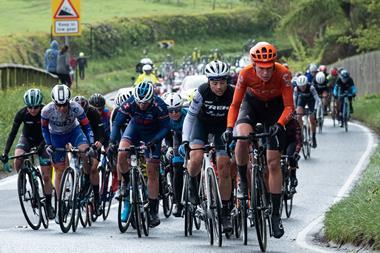With so much at stake for elite athletes as well as a growing amateur market, Gore, inventors of the world-renowned Gore-Tex material, explain how designed experiments help them stay ahead of the pack.
With the Covid-19 pandemic causing the postponement of the Tokyo Olympics and marathons around the world, debate over Nike’s controversial Vaporfly shoes – the trainers that can improve marathon times by minutes in elite athletes – has quietened down temporarily. But the advantage these shoes offer to elite athletes – and ordinary runners looking to beat their personal bests – has already caused major upset in the running world. Long-standing records have been smashed, and competitor brands are racing to catch up.
Ethylene-vinyl acetate (EVA) has long been used in the midsoles of running shoes because it is light, cheap to produce and provides plenty of cushioning. However, its random copolymer composition means foam suppliers can only vary its characteristics so far. Nike’s breakthrough has been partly thanks to its use of ZoomX, a proprietary version of Pebax, harnessing its block copolymer properties in the Vaporfly and other shoes in the range. This high-performance, lightweight foam coupled with a curved carbon fibre plate patented by Nike creates a spring effect that ensures less energy is lost with each step. Put simply, this means that good runners can run faster for longer.
Competitive swimming experienced a similar breakthrough in the early 2000s when full-length body suits became the standard. When Speedo introduced the LZR Racer in 2007, with its polyurethane construction and ultrasonically welded seams, swimmers started to achieve even better streamlining and buoyancy. The LZR prompted a wave of imitations, and in the 17 months following its launch, 130 world records fell.The suits were banned from competition in 2010.
While the Vaporfly has not been banned in competition, World Athletics has put a temporary suspension on any subsequent new shoe technology featuring at the Olympics – before it was postponed. The governing body intends to conduct further research into the effect on athletic performance of the foam used and the construction of running shoes.
Achieving the discipline for innovation
Where does this leave the researchers and scientists racing to develop the next major breakthrough in sportswear technology? Sporting regulations are unlikely to put the brakes on innovation. The ability to deliver a significant advancement in technology at an affordable, mass-market price tag is a prize many brands will keep chasing. As costs come down and competitors catch up, Nike may not hold its advantage for long.
We look at the data and make data-based decisions. It’s not like guessing or a gut feeling. Analytics is really deeply embedded in our organisation.
Maria Lanzerath, global head of statistics, Gore
For WL Gore, the discovery of expanded PTFE in 1969 transformed its business and revolutionised waterproof, breathable fabric membranes. The diamond logo label of Gore-Tex has been a mark of excellence in outdoor clothing and footwear for decades: its ‘guaranteed to keep you dry’. Gore’s more recent innovation, Gore-Tex Infinium, is used in technical sportswear to deliver superior protection in drier conditions. Its wind-proof, ultra-thin properties promise to boost performance and improve comfort. Gore’s product technologies combine different benefits to improve performance across a wide range of weather conditions and activities.
For those organisations at the cutting edge of innovation in sports technology, taking a strategic, data-driven approach helps scientists and engineers work more productively. They are able to extract more valuable insights from their experiments while also reducing product development costs. It is the discipline required to achieve headline-grabbing breakthroughs in research and development. Improved predictability helps with planning and enables more efficient ways of working. With the right tools available to manage the process, organisations can make better decisions quicker, meet project milestones more predictably and get to market faster with their latest game-changing developments.
Keeping ahead of the curve
It is exactly this kind of disciplined approach to innovation that drives WL Gore’s development of new technologies and products. Gore’s ability to stay ahead of the curve comes from the organisation’s continued reliance on science not only in product design but also in every aspect of its manufacturing processes worldwide.
The statistics team supports a wide range of Gore’s operations, ensuring data-driven decision making while also freeing up some of the industry’s most forward-thinking engineers to focus on product and process design.
Maria Lanzerath, global head of statistics at Gore, explains the difference that data analytics makes for the organisation: ‘We look at the data and make data-based decisions. It’s not like guessing or a gut feeling. Analytics is really deeply embedded in our organisation.’
Statisticians at Gore partner with engineers and scientists across the organisation to ensure quality and reliability in all aspects of the business. Lanzerath works with internal cross-functional teams of process engineers and scientists within Gore’s global operations to address specific needs or challenges. Her team uses statistics to monitor and improve quality in both Gore’s products and the processes used to make them. Lanzerath says that in Gore’s textile processing operations, the team faces considerable variability in the products they manufacture thanks in part to the volatility of the raw materials involved. Variability, she says, ‘is a challenge for production that requires good methods and process understanding.’
The statistics team supports a wide range of Gore’s operations, ensuring data-driven decision making while also freeing up some of the industry’s most forward-thinking engineers to focus on product and process design.
Data analytics drives results
Data analytics helps Gore’s teams to ask the right questions, gather the right data and arrive at the right decision. Lanzerath says this approach allows her to solve even the most complex manufacturing challenges. Using design of experiments (DOE), Lanzerath’s team can set up analyses that are specifically tailored to the needs of Gore’s engineers.
I can’t imagine our technical organisation without designed experiments and all of these data analysis tools [that enable us] to ask good questions and arrive at a data-driven decision
Maria Lanzerath
‘With DOE, I can put together trials under certain conditions to determine an operating window for a specific production process,’ Lanzerath says. ‘For example, when we [use an adhesive to] laminate PTFE films to a textile, we have to choose a temperature, process speed, tension and pressure, and identify how best to press the two materials together. In other words, we have multiple factors at the same time that have to work with each other.’
In a mathematical sense, solving this problem could involve either a multivariate or multifactorial model. ‘We pick certain factor combinations, try them out and learn from 20 or 30 trials. Although there could have been a thousand potential combinations, we only need to run a few to identify the optimal process window,’ Lanzerath says. ‘I can’t imagine our technical organisation without designed experiments and all of these data analysis tools [that enable us] to ask good questions and arrive at a data-driven decision.’
Delivering innovation for all
Some sports technology innovations create a step change at elite level, smashing records and leaving governing bodies struggling to keep up. Some enhance human endurance in the harshest of climates and make groundbreaking achievements possible.
With the imposition of social distancing guidelines across the world following the outbreak of Covid-19, the focus may have shifted away from major sporting events and professional team sports. But solo sports such as cycling, running and hiking have received an unexpected boost in popularity in some countries. After all, for most consumers of technical sports gear, comfort and reliability are the main requirements and can make all the difference to our enjoyment and ability to take part.
Whatever the objective, the researchers and developers pushing the boundaries and transforming sporting performance for those at the front of the pack are just as important in changing the game for the masses.


















No comments yet